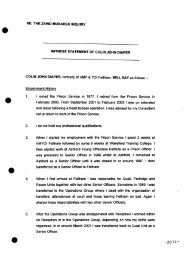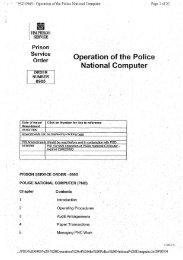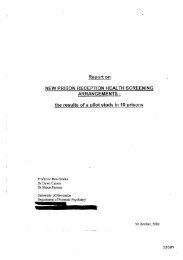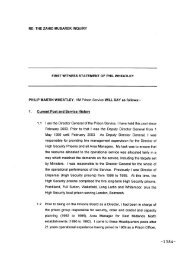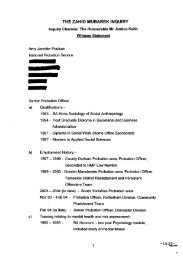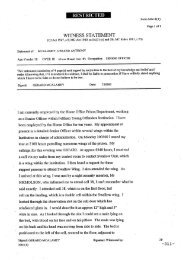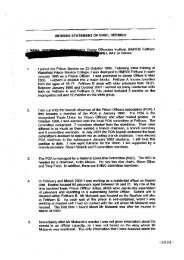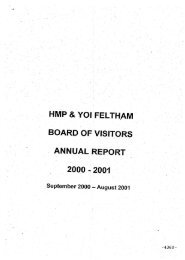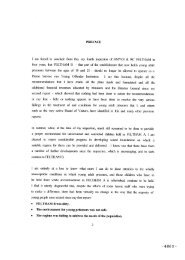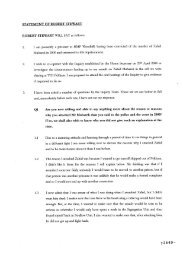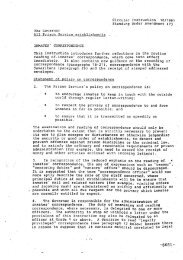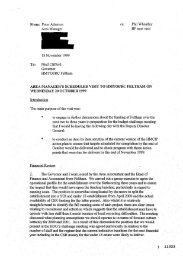RE: THE ZAHID MUBAREK INQUIRY WITNESS STATEMENT OF ...
RE: THE ZAHID MUBAREK INQUIRY WITNESS STATEMENT OF ...
RE: THE ZAHID MUBAREK INQUIRY WITNESS STATEMENT OF ...
- No tags were found...
Create successful ePaper yourself
Turn your PDF publications into a flip-book with our unique Google optimized e-Paper software.
<strong>RE</strong>: <strong>THE</strong> <strong>ZAHID</strong> MUBA<strong>RE</strong>K<strong>INQUIRY</strong><strong>WITNESS</strong> <strong>STATEMENT</strong> <strong>OF</strong> STEVEN MARTINDALESTEVEN MARTINDALE, of HM Prison Winchester WILL SAY as follows: -.Employment History1. I joined the Prison Service in January 1986 and presently work at HM PrisonWinchester as a Senior Officer.2. In 1986 my first placement was also at HM Prison Winchester, as a new entrantPrison Officer. I spent the first three weeks shadowing/observing other officers indifferent parts of the prison. I then went to the Officers Training School (OTS) atLeyhill for a nine-week residential course. I was then posted to Feltham YoungOffenders Institute. After a year on probation my position was confirmed.3. My first job at Feltham was working on the Therapeutic Wing that was geared to apreparation regime for young offenders who had received a sentence that wouldtake them past their 21st birthday, at which point they would be transferred to anadult prison. I worked there for about four years.4. For the year after that I worked on the (convicted) workers wing. These were thekitchen workers who, because of the hours they worked, were on a differentregime from the other prisoners.1 -921 -
5. It was whilst I was on that wing that I took and passed the promotion exam. Thiswas a national examination run by the Prison Service consisting of both writtenpapers and an oral interview before the National Board. I was promoted to thegrade of Senior Officer and posted to HM Prison, WormwoodScrubs.6. I worked in Wormwood Scrubs for two years running the Remand Wing and then,in approximately 1993, returned to Feltham where I worked for five years first onthe Induction Wing (Lapwing) and then one year on prisoner discharge. I thenwent back to the Induction Wing for 18 months and then in January/February of2000 moved to the Reception Unit.7. In 2002 I transferred to Winchester where I worked on the Induction Wing and thesex offenders wing.I am currently night manager at the prison.Job description8. In February 2000 I took up the Senior Officer position on the Reception Unit atFeltham. I was the officer in charge. This was largely weekday work but I was ona roster working one weekend in three. The work of Reception was to receiveprisoners from the Courts and to discharge those prisoners whose sentence wascompleted. Some of the prisoners we received would be based at Feltham andwould pass through on their way back to .the cell they already occupied. Otherprisoners, who were there during the course of a trial or on transfer or some otherreason, would be passed from Reception to the Induction Unit where they wouldbe interviewed and allocated to a wing and a cell.9. My line manager and reporting officer at that time was Principal Officer PaulClark. He was my first link in the management chain, so far as I was concerned.As to my staff, on each shift there would normally be six prison officers (includingtwo from the security section) plus a nurse or hospital officer. For the eveningreception period a doctor was also present. Four of the prison officers werespecifically tasked with escorting prisoners either back to their wing or to theInduction Unit.2 -922-
10. I took the responsibility of seeing each prisoner on arrival, primarily to check thatthe Warrant for their detention was correct and also that they fell within therelevant age group i.e. over 18 but under 21 years. If there were a medical issuethen this would be dealt with by one of the medical staff and/or the doctor. Havingmade the initial important checks I would then pass the prisoner to my staff toprocess.11. We used to receive up to 100 prisoners every weekday. Many were already inthe prison system but it was possible for us to receive entirely new prisoners i.e.those who had been arrested that morning, taken to Court and remanded incustody. In relation to these new prisoners we would create the initial paperworkthat would subsequently become part of their core file.12. Not only, as a London prison, were we extremely busy but, at short notice, wewould also receive prisoners whose trial had over run and where there was nottime to take them back to prisons such as Aylesbury, Reading and Lewes i.e.from a very wide area. In those cases we would get a short notice call fromGroup 4. I remember there were some occasions when we had no space at allbut that prisoners would arrive and there was absolutely no choice but for us totake them as there was literally nowhere else for them to go.Zahid Mubarek13. So far as I am aware during my time at Feltham I never met or had any contactwith Zahid Mubarek.Robert Stewart14. On 10 January 2000 Robert Stewart came on the Induction Wing. I noticed thathe had "R.I.P." tattooed on his forehead and also had a number of other tattoos.It was, in fact, not unusual for prisoners to have many tattoos including thosevisible on the neck and/or face. I cannot recall for certain now if I carried out theinductioninterview myself, but I am sure I talked to him.3 -923-
15. At that stage in my career I had been in the Prison Service for about 14 years andwas very experienced and, in particular, had dealt with many young prisoners. Ontalking to Stewart I had what I can only describe as a "gut feeling" that he neededto be watched. He seemed to be something of a loner and did not particularlymix with the other prisoners. I thought he was 'strange' and had a quietlyintimidating manner. I am fairly sure that I mentioned this straightaway to mystaff and I remember making sure he was placed in a single cell. This was, infact, a fairly common practice in Lapwing in relation to an 'unknown quantity' or tosomeone over who there might be doubts, however slight or unsubstantiated atthe time. It did not relate to the fear of a threat to a cellmate; we had the spaceand it was just a normal precaution. It was just for overnight and would not havebeen recorded as of significance.16. On the Induction Unit we received about 70 new prisoners a week; it was unusualto receive a prisoner late in the evening. There was never a time when only asingle officer was on duty to receive a prisoner. Even after the end of a shift I wasoften around preparing for the next day, sorting paperwork etc and it was notunusual for me to still be on Lapwing at 9.00p.m.17. All prisoners were interviewed individually. Whilst I did not always do the formalinterview, I tried to see as many of them as I could. The interview itself was fairlystructured with a view to getting basic useful information. For example, weneeded to know the next of kin, home address, any problems, solicitor details etc.It would usually take about ten minutes and be recorded on the flimsy file or theObservation Book. It was my personal policy not to know the offence for which aprisoner was in prison. Sometimes a prisoner would come to the Induction Unitwith a "flimsy" file and sometimes not. If he did I would generally not read thisuntil after I had spoken to him as I very much wanted to form my own unbiasedopinion. As I set out further below, at paragraph 24, subsequently I did seeStewart's security file.18. As part of the process of getting to know a prisoner and forming an opinion onhim I had a policy of having my staff read as much incoming and outgoing mail as4 -924-
possible. From the security angle we were looking for anything on escapes orthreats of violence; on prisoners we were looking for anything on self-harm orpossible domestic or family problems: generally we were looking for anyconfessions or comments about crime.19. The general guidelines were for five per cent of mail, in or out, to be read(although those seen as an escape risk would be given special attention) but Iwould estimate that, on Lapwing, 75 per cent of mail was seen. In relation toStewart I remember that, on 12th January 2000, Prison Officer Debbie Hoggbrought me a letter Stewart had written to be sent out. It contained references tothe comparison between the numbers of black people at Feltham with the numberat the Manchester prisons he had been in before. It was not threatening but wasgenerally racist in nature and referred to "niggers". I cannot recall if it referred to"Pakis".20. Prison guidelines suggest that such a letter should be seized and recorded in thewing "Stopped Letters Book" and possibly a Security Information Report (SIR)completed and filed. However, officers are allowed to exercise discretion onbreaches of the Rules and I regarded one of the main jobs on the Induction Unitto be to prepare young prisoners (some of whom were in prison for the first time)for life in prison and, consequently, I adopted a less strict policy in relation tomatters such as inappropriate letters.21. The language used by the young prisoners amongst themselves, both verballyand written, was often aggressive, boastful and 'foul-mouthed'. Often youngprisoners just did not understand that what they said or wrote was unacceptable,inappropriate or offensive. In this respect they needed direction and guidance.Additionally, to raise an SIR on this for a prisoner only staying for a night or twowould have not been a practical way of dealing with the issue.22. Therefore, in the majority of cases, we returned an unsuitable letter to theprisoner and counselled/advised him why it could not be sent in its current formand that it needed to be re-written, in acceptable language. My view was that itwas better, in most cases, to resolve these sorts of issues in a less heavy-handed5 -925-
way at the outset and that this approach was of benefit for the long-termrelationshipof staff and prisoners.23. In this particular case the letter was returned by Officer Hogg to Stewart and, inmy presence, she advised him why it was unacceptable. She warned him not towrite in a racist way again and told him that his future mail would all be checked.Although no direct action was taken against Stewart Officer Hogg did made anentry about the letter on Stewart's "flimsy" file.24. I think it was shortly after this, but on the same day, that Senior Officer RobertBenford who, at the time, was working in the Security Office at Feltham where themain files on prisoners were kept, contacted me. He asked me to come over tothe Security Office and he showed me Stewart's security file (such files never goon the wings but are held centrally). It is not unusual for officers (myself included)to go and look at such files but being asked by Security to come only happenedoccasionally. Officers could go from the wing during a shift if staffing levelsallowed or at the start or end of a shift or during lunchtime. I do not know if anyone but me went to see the file.25. Stewart's file was two or three inches thick and was one of the biggest I had everseen. I spent about 5 to 10 minutes looking through it. Mr Benford and I thenhad a brief conversation in which we agreed that Stewart was a danger both tostaff and inmates. He said he would make his staff aware of the content of thesecurity file and I told him that I would write a note for my staff about it.26. Having read the file I formed the impression that Stewart was dangerous and athreat to anyone, staff or fellow in-mate. His file covered acts of violence, use ofweapons (I noted that he had stabbed an inmate in the eye); potential escapeand he had been implicated in a previous prison murder. There was nothing therethat alerted me to the particular possibility that he would carry out a racist attack.Had I not been called by Mr Benford I think it unlikely that I would have gone tosee the security file, just on the basis of my 'feeling' about Stewart.27. Back on the wing I felt it important that staff were warned about Stewart as I6 -926-
thought him to be dangerous, both to staff and other prisoners, although I hadnothing specific in mind. Therefore, I relayed my feelings and what I had readdirect to my staff. I also obtained Stewart's "flimsy" file and, in red capitals, wrotean entry that stated "STAFF A<strong>RE</strong> ADVISED TO SEE <strong>THE</strong> SECURITY FILE (INSECURITY) ON THIS INDIVIDUAL. HE IS A VERY DANGEROUSCHARACTER. PLEASE BE CA<strong>RE</strong>FUL" (IB 383). I also wrote "* SEE INNERPAGE" on the front cover of the file, again in red. I attach a copy of this entry (IB374). Additionally, I placed another warning entry about him in red in the LapwingObservation Book (IB 976). I expected my staff to keep themselves up to date onsuch entries and they were also there to warns others, for example on anotherwing on transfer or allocation. I cannot now say, after all this time, in what orderthese entries would have appeared on the file.28. I feel I took appropriate action, both verbally and in writing, to warn of a potentialbut necessarily unspecific danger. With hindsight perhaps I could had taken moreaction over the stopped letter but there was discretion for me to act as I did and inthe past I found that a less strict approach in the Induction Unit was subsequentlyof benefit to both prisoners and staff.29. I had no involvement in wing or cell allocation in relation to Stewart and on 6February 2000 I transferred to the Reception Unit. This is the area of the prisonwhere prisoners are received or discharged. They arrive at the prison in variousways, often with little or no notice or documentation. There should always be aWarrant of Detention and, in the case of the YOI, evidence as to age. I haveexplained above, in paragraphs 8-12, the operation of the Unit.30. I recall that sometime after I started my new posting I saw Stewart in theReception Unit. It was evening and he was coming back into the prison. I did notdeal with him myself. I remember saying to Prison Officer Gordon Meek, whowas on duty, what a nasty piece of work Stewart was. I assumed that thecautionary note on his "flimsy" file would be with him to warn officers on whateverWing he went to. I do not believe that I saw Stewart again either before or afterthe incident on 20/21 March 2000.7 -927-
31. In relation to passing information about a prisoner up and down themanagerial line there was a great deal of verbal exchanges of information bothwithin and across the wings. Written comments were kept in various forms bothon the wing, e.g. flimsies, Observation Book, Occurrence Book and morecentrally e.g. the Security File in the Security Unit. All these were available to staffat all levels and to both the officer and governor grades.Zahid Mubarek'smurder32. I had no involvement with the events that took place during the course of thenight of 20/21 March 2000.I subsequently was interviewed by the police and attach a copy of my police statementof 11 May 2000 (WB 285-287). I was also interviewed twice during the ButtInvestigation and attach a record of those interviews (WB 288-295)33. I was also interviewed on 18 April 2001during the course of the Commission forRacial Equality's Formal Investigation. I attach to this statement a copy of thetranscript of that interview (WB 296-310). I refer below to my dealings with theC<strong>RE</strong> but in particular at this point would say that the transcript was sent to me foragreement a year after the interview took place. Although I signed the"Certificate of Truth" sent with the transcript I feel it is incomplete. At one pointduring the interview I was concerned that it was, in fact, becoming aninterrogation and raised the question of whether or not I should have a lawyer orsomeone else present on my behalf. I was persuaded that this was notnecessary but this exchange was not recorded or transcribed.34. In January 2003 the C<strong>RE</strong> sent me a copy of an extract from their draft Reportwhere my involvement with Stewart was detailed. I was concerned withinconsistencies and errors in what I had been sent. It appeared that they hadtaken passages from my various interviews, put them together and then quotedor referred to them out of context.35. Letters were written on my behalf to the C<strong>RE</strong> pointing out the mistakes and the8 -928-
inconsistencies but unfortunately the published Report still contains errors andspeculation. In particular the Report connects the letter stopping incident and myvisit to read Stewart's file as if one led to the other. These were separateunconnected events, both actioned but in different ways.Attacks by one prisoner on another36. Assaults of various degrees of seriousness between prisoners are almost a dailyoccurrence in any prison. Occasionally they can be very serious but, for the mostpart, they amount to little or no physical violence. Attacks by one cellmate onanother are, in my experience, very rare. I can recall no other incident all the timeI was at Feltham. Cell-sharing or extended confinement does not seem to be afeature of increased violence, which is something that occurs when prisoners areintermingling rather than when separated in their cells. However, lack of activitycan have an affect on behaviour. If I were aware of any tension betweencellmates I would move one of them, to prevent any trouble before it started.37. In relation to Feltham any tension there was between prisoners occasionallyleading to physical confrontation arose from members of various gangs beingincarcerated together. Sometimes the gang disputes that took place outside theprison would be reflected in something similar inside. In relation to acts ofviolence Feltham was not a great deal different to anywhere else I have served.Race Relations38. I would not have said that there was any particular tension or conflict betweenprisoners of different ethnic origin at Feltham. In fact there was a good deal ofmixing of various groups throughout the day. To a certain extent the prisonpopulation and attitudes at Feltham reflected the outside world where, in Londonparticularly, young people are now used to a multi-cultural society experienced inschools and from sporting or social events.39. The membership of the gangs I mention above in paragraph 38 was oftenrestricted to a particular group. However, any incidents of violence would tend tobe individuals of one white gang against another white gang and likewise for9 -929-
lack gangs.gang or vice versa.I cannot recall an incident of a white gang member attacking a black40. I do not believe that a prisoner's ethnic origin played any part in decisions inrelation to the allocation of Wings, cells or indeed in any other area of the prisonregime.Practice and Procedure41. I have already dealt with above issues in relation to: -• The assessment or interview of prisoners on arrival at Feltham.• The induction process for prisoners on arrival at Feltham.• The process by which prison officers at Feltham familiarised themselveswith prisoners (in relation to the roles and responsibilities of the personalofficer I mention these below).• The observation of prisoners by prison officers and the means by which anyobservations or concerns were recorded.• The means by which and the circumstances in which concerns regarding aparticular prisoner were passed up the management chain.42. A prisoner is allocated a personal officer (there is also a deputy) who is always tobe the prisoner's first point of contact on the Wing with any comments, complaintsor suggestions. However, it is not all one way and an officer will take particularinterest in the welfare of those prisoners for whom they have this specialresponsibility. Training is available for officers to carry out this role as effectivelyas possible. I have been a personal officer during my career but not for severalyears.43. In relation to obtaining medical advice concerning a prisoner I have explainedabove the procedure and availability of doctors/nurses/medical staff in theReception Unit.44. Any prisoner can "report sick" and receive the appropriate attention. If an officer10 -930-
felt that a prisoner was ill or should receive medical attention they would encouragethe prisoner to seek this and, if there was reluctance, ensure that an appropriatemember of the medical staff saw the prisoner. In relation to matters such aspotential self-harm, of one sort and another, there were special procedures toensure that medical staff was involved with a prisoner liable to inflict this.45. I have dealt with the monitoring of letters above.46. The allocation of prisoners to particular Wings or cells took place after inductionand I had no direct involvement with this. As far as I am aware, at the relevanttime at Feltham, apart from, for example, vulnerable prisoners, inmates wereallocated to the wing/cell on the basis of where there was space for them to go,as we were very pressed with the number of prisoners with which we had to deal.47. If there were a real fear of a prisoner being attacked by other prisoners then thesafest method of their protection would be to either persuade them (or directthem) to be separated from allocation on the main wings and to lodge them under"Rule 43" in a separate Unit. A prisoner could ask for this and such a requestwould always be seriously considered. If it were felt by prison staff that a prisonershould be segregated for his own benefit/safety then the first step would be topersuade him to apply for that status. In serious cases or where a prisoner wouldnot opt for this route then he could be "put on Rule 43". Only a Governor gradecould make this decision and Order.48. Any violence or aggression, however slight, is always taken very seriously. Noprison officer would want bullying or violence to take place. It is important to 'nipin the bud' any incidents before they can develop into something serious. Allreports of violence are taken very seriously, reported and action carried out.49. In my experience there would always be a hand over from one shift to another.This would normally be a verbal exchange of information but it could alsohighlight entries in local logs, observation books etc. I would expect incomingstaff to always fully apprise themselves of incidents or situations that may haveoccurred during the previous shift. If staff had been away from the Prison, on11 -931-
leave or training, when they came on to duty I would expect them to readthemselvesinto the relevant recent notes to be up to date.50. Communication between different establishments about behaviour of a particularinmate would take the form of an entry on the prisoner's "flimsy" file and/or themain file. Between different parts of Feltham those documents would also berelevant but so too would verbal updates.51. Full cell searches were carried out every three months and there would be a daily"locks, bolts and bars" search that included checks on fabric. If, for example, apiece of furniture were damaged then attempts would be made to repair it. If itcould not be repaired and was it either a health risk or could become a potentialweapon then that piece of furniture was removed and replaced.52. A violent and/or dangerous prisoner would be lodged in the Segregation Unit.53. It was an essential part of the job for all officers to be aware of any potentialbullying, assaults or intimidation. Each prisoner had a personal officer to whomthey could speak. There are also other outlets independent of prison staff towhom prisoners could express concern e.g. the BOV, the Samaritans, theFriends of Feltham, prison visitors etc.54. All incidents of racism, or perceived racism, amongst both prisoners and staff aretaken seriously. In particular, with regard to prisoners a range of actions wouldbe taken dependent on the particular incident. At one end of the scale this mightbe warning to a prisoner as to his future conduct and, at the other, by charginghim with an offence and carrying out an Adjudication.55. The Prison Service is a national one with the same Rules and proceduresapplying in all prisons. Although there my be some local variation on minormatters I am not aware of one prison being different from another in relation tothe above serious issues.Trainin.q12 -932-
I56. Over the course of my career I have received training in a great many areas,for example control and restraint, food handling/hygiene, general managementcourses, counselling, suicide risk and assessment training. In particular I havereceived race relations training and I recall a one-day course held at Feltham ledby the Race Relations Officer.57. Clearly, the quality of the training has varied somewhat from course to course butoverall I feel that I have received adequate training in a great many areas ofprison operation and that it has been of benefit to me in my job.Record keepinqI58. I have set out above comments on files and sources of information in relation toindividual prisoners and the circumstances in which I would, and in RobertStewart's case did, contribute to these. In my second interview with Mr Buttreference is made to "police one form" and "old page 24". The document called "POLl" was a replacement form and was, in effect, a warning letter covering suchmatters as the possibility of extreme violence, escape risk, sex offender etc.59. I would expect any officer to be aware of the contents of the documentation heldon the wing. This was very straightforward to do. A prisoner's main and/orsecurity file would also always be available in the prison and any officer orgovernor had the opportunity to read this.I60. I regarded the system of using flimsy files as very important. It was my practice,on passing a prisoner to a wing with his 'flimsy' to get a receipt for it to show ithad passed been on. I was aware that sometimes these files were left behind atReception when a prisoner moved on and I made it my practice to collect any ofthose left and keep them in Lapwing in case a prisoner passed through again aswe would then have a record on him. Generally speaking prisoners would have aflimsy that followed them around usually actually travelling with the escortingofficers. Within Feltham I do not think that there was a problem about creating orpassing on flimsy files.13 -933-
61. The computer system in operation at Feltham was the Local InformationData System (LIDS) and that has been in place, I believe, since 1987. I do notknow what the system at Feltham is like now but at the time I was there it did notcontain any significant information and was a basic record device. I now use anupdated version of LIDS which is capable of recording much more information.Supervision62. My Line Manager was Principal Officer Paul Clark but as a Senior Officer I hadday-to-day operational control where I worked and for the prison officers whoworkedin that area. On a Wing or Unit you work very closely with colleagues.63. Mr Clark had responsibility for various parts of the prison and other SeniorOfficers but was always available to me to discuss matters if required.see him on a daily basis.I wouldOther witnesses64. I am not aware of any other individuals, not already identified by the Inquiry,whom I think would have useful information.<strong>STATEMENT</strong><strong>OF</strong> TRUTH:I believe that all facts stated in this Witness Statement are true.Signed: ...............................................................STEVEN MARTINDALEDated: ............... JULY 200414 -934-



